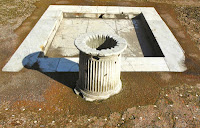 |
| Perseus fresco |
So here are 12 child-friendly tasks for you to do in the Bay of Naples. They range from easy to challenging and you will have to get your parents to help!
1 Sorrento is famous for its lemon groves; try a lemon sorbet or - if your parents are agreeable - get one of them to order limoncello after dinner and ask for a sip, but just a sip! It is very strong.
 |
| rope marks on the well-head |
2 Visit Herculaneum and find ancient rope-marks on one of several marble well-heads by the impluvia (rain-water pools) in some villas.
3 Have Sanbitter (a bright red, non-sweet, non-alcoholic Italian aperitif) and nibbles on the terrace of the Hotel Bellevue Syrene in Sorrento; ask if you can see the Roman rooms downstairs first, to help make the cost of your drink worth it!
 |
| funny ducks mosaic in Naples |
5 Visit the so-called Villa of Poppaea AKA Oplontis (at Torre Annunziata on the Circuvesuviana Sorrento-Naples train line) and look at the cake-like layers of tufa (hardened ash) and papilli (light volcanic pebbles) that Vesuvius laid down.
6 Find the public water spouts in Castellammare di Stabia and taste one of seven different types of mineral water.
7 Go all the way into the Blue Grotto in Capri.
 |
| Villa of Pollius Felix (model) |
9 Swim in the secret cove of the Villa of Pollius Felix on the Capo di Sorrento. (OK, then, just take a photo...)
10 Find the little fresco of Perseus with the head of Medusa (top of this post) at the Villa San Marco at Castellammare di Stabia. You'll have to get a taxi at Castellammare di Stabia, but it's worth it.
 |
| Temple of Mercury, Baia |
12 Take a hot mud (fango) bath in the oldest spa on the island of Ischia. Or visit one of the modern baths like Negombo.
These "tasks" are adapted from the Roman Mysteries Travel Guide: From Ostia to Alexandria with Flavia Gemina, now available on Kindle. And if you want some good reading, try the three Roman Mysteries set on the Bay of Naples: The Secrets of Vesuvius, The Pirates of Pompeii and The Sirens of Surrentum. Buon Viaggio!





